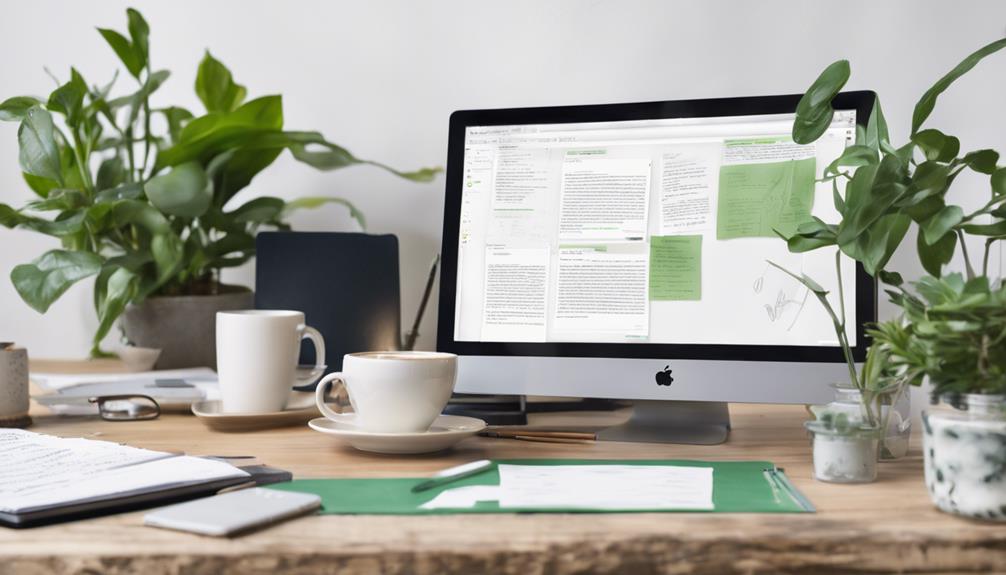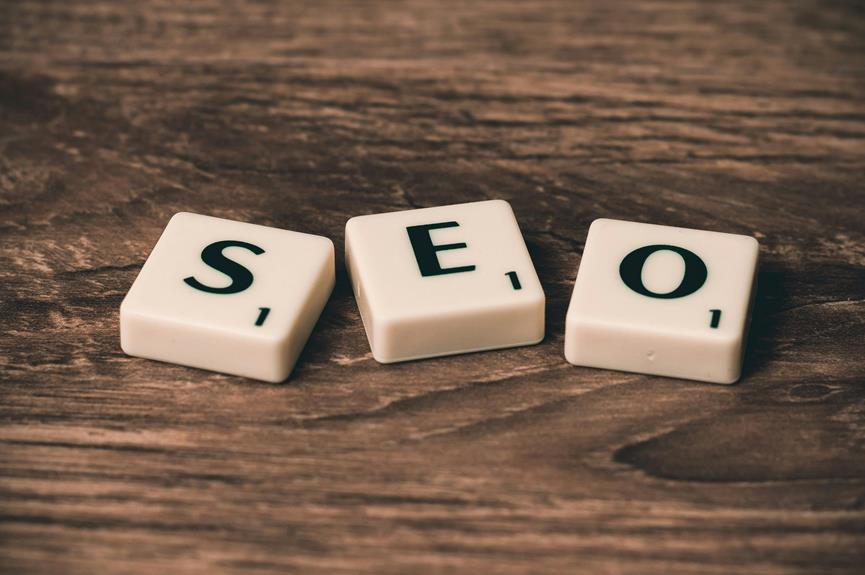If you're looking to improve your website's visibility, focusing on on-page SEO is crucial. Start by ensuring your keyword research is thorough, allowing you to target terms that can actually make a difference. But that's just the beginning. Crafting effective meta tags can boost your click-through rates, while improving readability keeps visitors engaged. And don't forget about images; optimizing them can enhance your page's performance. However, perhaps the most strategic move is refining your internal linking. Curious about how to implement these tips effectively? Let's explore each of these strategies in more detail.
Key Takeaways
- Identify and incorporate long-tail keywords with high search volume and low competition for improved conversion rates.
- Craft concise, keyword-rich title tags and meta descriptions to align with user intent and enhance CTR.
- Use short sentences, subheadings, and bullet points to improve readability and skimmability of content.
- Optimize image attributes with descriptive file names and alt text, and compress images for faster load times.
- Use keyword-rich anchor text for internal links to distribute link equity and improve site navigation.
Keyword Research and Optimization
Effective keyword research and optimization are the backbone of any successful on-page SEO strategy. You need to start by identifying relevant keywords with high search volume and low competition. Use tools like Google Keyword Planner or Ahrefs to gather data on keyword performance.
Focus on long-tail keywords, which are more specific and often convert better due to their targeted nature. Once you've got your list, it's crucial to integrate these keywords naturally into your content. Your primary keyword should appear in the title, first paragraph, and subheadings—ensuring search engines recognize the content's relevance.
But don't overdo it; keyword stuffing can lead to penalties. Aim for a keyword density of about 1-2% to keep it natural. Utilize latent semantic indexing (LSI) keywords, which are conceptually related terms, to provide context and improve the content's comprehensiveness.
Analyzing competitor keywords can offer insights into what works within your industry. Track keyword performance regularly using analytics tools. This data-driven approach allows you to tweak your strategy, focusing on high-performing keywords and adjusting underperformers.
Enhance Meta Tags Effectiveness
Meta tags play a crucial role in on-page SEO by directly influencing how search engines interpret and display your content. To enhance their effectiveness, focus on crafting concise and relevant title tags and meta descriptions for each page.
Research shows that title tags should ideally be between 50-60 characters to avoid truncation in search results, while meta descriptions should remain under 160 characters. Incorporate primary keywords naturally within these tags to align with user search intent.
Avoid keyword stuffing, as this can negatively impact your SEO ranking. Instead, prioritize clarity and relevance. Tools like Google Search Console can help you identify keywords that drive traffic, enabling you to optimize your meta tags accordingly.
Ensure your title tags are unique and accurately reflect the content on the page. Search engines favor pages where the meta tags correspond closely with the actual content, improving click-through rates (CTR).
Additionally, use compelling language in your meta descriptions to entice users to click on your page. A higher CTR can signal to search engines that your content is valuable, further boosting your ranking.
Improve Content Readability

While optimizing meta tags sets the foundation for on-page SEO, improving content readability is equally significant in ensuring your audience stays engaged. A well-structured article enhances dwell time, reduces bounce rates, and boosts SEO rankings.
Start by using short sentences and paragraphs; research indicates that 85% of users prefer content that's easy to skim. Break text with subheadings and bullet points, which improve scanning by 47%.
Use simple language and avoid jargon to broaden your audience reach. Flesch Reading Ease scores are a valuable tool, recommending a score above 60 for general content. Incorporate active voice, as it simplifies comprehension and creates a direct connection with the reader. Transition words like "however," "moreover," and "consequently" guide readers through your narrative smoothly.
Focus on keyword placement naturally within your content. Keywords should appear in headers, the first 100 words, and sporadically throughout. Maintain a keyword density of 1-2% to avoid keyword stuffing, which may harm your ranking.
Optimize Image Attributes
Images play a pivotal role in your website's on-page SEO, enhancing both visual appeal and user engagement. To optimize image attributes effectively, start by using descriptive, keyword-rich file names. Instead of "IMG_1234", opt for something like "blue-widget-example". This practice helps search engines understand the content and context of your images, boosting their indexing potential.
Next, focus on alt text, which serves as a substitute for images if they can't be displayed. Use clear, concise descriptions incorporating relevant keywords. Alt text not only improves accessibility for visually impaired users but also provides search engines with more information, contributing to better rankings.
Ensure that your images are properly compressed to minimize load times, as page speed is a critical ranking factor. Tools like TinyPNG or JPEG Optimizer can significantly reduce file sizes without compromising quality. Remember, larger images slow down your site, potentially affecting user experience and SEO performance.
Lastly, use structured data markup like Schema.org to provide additional context. This can enhance image search results and increase click-through rates.
Strengthen Internal Linking Strategy

A robust internal linking strategy acts as the backbone of your website's SEO architecture, guiding both users and search engines through your content efficiently. By connecting related pages, you enhance user experience and distribute link equity across your site. You'll want to identify key pages, optimize anchor text, and maintain a logical site hierarchy. Prioritize links to high-value pages, ensuring they receive a significant share of the link juice, boosting their visibility in search results.
Here's a concise guide to optimizing your internal linking strategy:
| Strategy Element | Best Practice |
|---|---|
| Anchor Text | Use descriptive, keyword-rich phrases |
| Link Quantity | Integrate 2-5 internal links per page |
| Site Structure | Maintain a flat architecture for easy navigation |
| Orphan Pages | Regularly check for and link orphan pages |
| Content Relevance | Link to contextually relevant content |
Focus on using anchor text that's both descriptive and keyword-rich. Consistency in linking patterns helps search engines understand your site's focus areas. Don't forget to address orphan pages—those without any internal links—as they can hinder discovery and crawl efficiency. By refining these aspects, you reinforce your site's SEO foundation, enhancing its overall search engine ranking potential.
Conclusion
By implementing these five essential on-page SEO strategies, you can significantly enhance your site's search rankings. Start with thorough keyword research to target high-volume, low-competition terms, and integrate them naturally. Optimize your meta tags to be keyword-rich and concise. Improve readability with short sentences and clear subheadings. Don't forget to optimize your images with descriptive filenames and alt text. Finally, strengthen your internal linking strategy for better navigation and relevance. These steps will drive more organic traffic to your site.


Leave a Reply